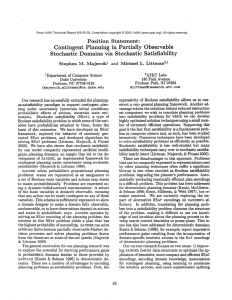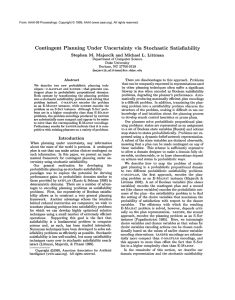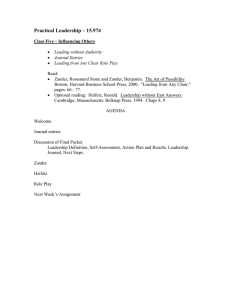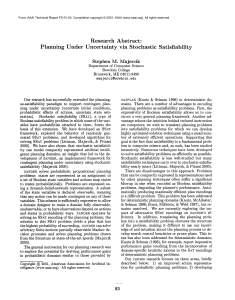Planning Under Uncertainty via Stochastic Satisfiability Stephen M. Majercik
advertisement
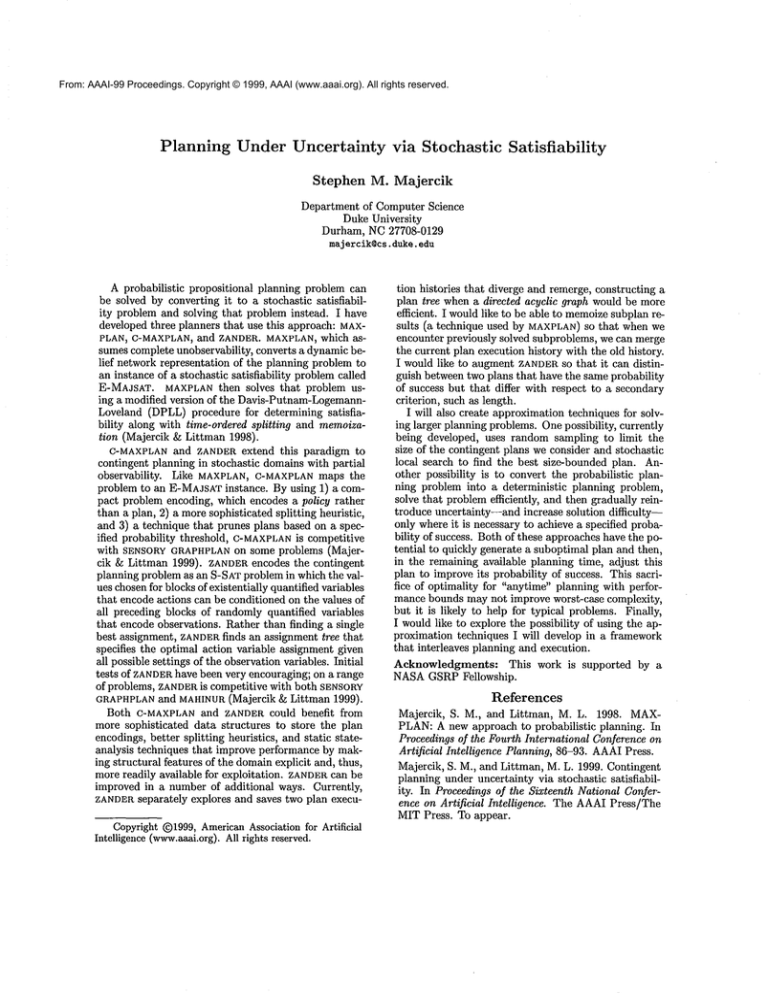
From: AAAI-99 Proceedings. Copyright © 1999, AAAI (www.aaai.org). All rights reserved. Planning Under Uncertainty via Stochastic Satisfiability Stephen M. Majercik Department of Computer Science Duke University Durham, NC 27708-0129 majercik~cs, duke.edu A probabilistic propositional planning problem can be solved by converting it to a stochastic satisfiability problem and solving that problem instead. I have developed three planners that use this approach: MAXPLAN~G-MAXPLAN~ and ZANDER.MAXPLAN~ which assumes complete unobservability, converts a dynamic belief network representation of the planning problem to an instance of a stochastic satisfiability problemcalled E-MAJSAT. MAXPLAN then solves that problem using a modified version of the Davis-Putnam-LogemannLoveland (DPLL) procedure for determining satisfiability along with time-ordered splitting and memoization (Majercik & Littman 1998). C-MAXPLAN and ZANDERextend this paradigm to contingent planning in stochastic domains with partial observability. Like MAXPLAN, C-MAXPLAN maps the problem to an E-MAJSAT instance. By using 1) a compact problem encoding, which encodes a policy rather than a plan, 2) a more sophisticated splitting heuristic, and 3) a technique that prunes plans based on a specified probability threshold, C-MAXPLAN is competitive with SENSORYGRAPHPLAN on some problems (Majercik & Littman 1999). ZANDER encodes the contingent planning problem as an S-SATproblem in which the values chosenfor blocks of existentially quantified variables that encode actions can be conditioned on the values of all preceding blocks of randomly quantified variables that encode observations. Rather than finding a single best assignment, ZANDER finds an assignment tree that specifies the optimal action variable assignment given all possible settings of the observation variables. Initial tests of ZANDER have been very encouraging; on a range of problems, ZANDER is competitive with both SENSORY GRAPHPLAN and MAHINUR (Majercik & Littman 1999). Both C-MAXPLAN and ZANDERcould benefit from more sophisticated data structures to store the plan encodings, better splitting heuristics, and static stateanalysis techniques that improve performance by making structural features of the domainexplicit and, thus, more readily available for exploitation. ZANDER can be improved in a number of additional ways. Currently, ZANDER separately explores and saves two plan execuCopyright ©1999,AmericanAssociation for Artificial Intelligence (www.aa~i.org).All rights reserved. tion histories that diverge and remerge, constructing a plan tree when a directed acyclic graph would be more efficient. I wouldlike to be able to memoizesubplan results (a technique used by MAXPLAN) SO that when we encounter previously solved subproblems, we can merge the current plan execution history with the old history. I would like to augment ZANDER so that it can distingnish between two plans that have the same probability of success but that differ with respect to a secondary criterion, such as length. I will also create approximation techniques for solving larger planning problems. One possibility, currently being developed, uses random sampling to limit the size of the contingent plans we consider and stochastic local search to find the best size-bounded plan. Another possibility is to convert the probabilistic planning problem into a deterministic planning problem, solve that problem efficiently, and then gradually reintroduce uncertainty--and increase Solution difficulty-only where it is necessary to achieve a specified probability of success. Both of these approaches have the potential to quickly generate a suboptimal plan and then, in the remaining available planning time, adjust this plan to improve its probability of success. This sacrifice of optimality for "anytime" planning with performance bounds may not improve worst-case complexity, but it is likely to help for typical problems. Finally, I would like to explore the possibility of using the approximation techniques I will develop in a framework that interleaves planning and execution. Acknowledgments: This work is supported by a NASAGSRP Fellowship. References Majercik, S. M., and Littman, M. L. 1998. MAXPLAN:A new approach to probabilistic planning. In Proceedings of the Fourth International Conference on Artificial Intelligence Planning, 86-93. AAAIPress. Majercik, S. M., and Littman, M. L. 1999. Contingent planning under uncertainty via stochastic satisfiability. In Proceedings of the Sixteenth National Conference on Artificial Intelligence. The AAAIPress/The MIT Press. To appear.
